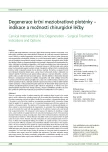Pulse Wave Analysis in Objective Evaluation of Pain – a Preliminary Communication
Authors:
K. Navrátil 1; J. Hálek 2; P. Havránek 3; S. Binder 2
Authors‘ workplace:
Klinika transplantační chirurgie IKEM Praha
1; Ústav lékařské biofyziky LF UP v Olomouci
2; Klinika dětské chirurgie a traumatologie 3. LF UK a FTNsP, Praha
3
Published in:
Cesk Slov Neurol N 2008; 71/104(3): 303-308
Category:
Review Article
Overview
The authors present the results of a peripheral pulse wave analysis obtained by screening the volume pulse of the radial artery with respect to the perception of pain. Time records of peripheral pulsation were used for the analysis in 26 patients (with an average age of 23.3 years) examined in rest and when feeling pain caused by routine surgical procedures (group l, n = 14, 53.8 % of patients) or present in a post-op period (group II, n = 12, 46.2 % of patients). An eleven-grade visual numeric scale or a universal pain assessment tool (UPAT) was used for subjective assessment of pain. The average value of the intensity of pain was 3.12 in group l and 2.33 in group II. The obtained curves were analysed visually and the results were processed statistically. Changes in the time course of the pulse wave were recorded in 25 cases (i.e. 96.15 %) during a pain experience. Two types of changes were observed – a split in the initial vibration with a loss of the characteristic dicrotism, and an expanding and levelling of the first vibration. In both the cases, relative delay in the onset of the second vibration was recorded on a non-constant basis. Both the types of changes occurred simultaneously on a single curve in 76.9 %, only the split occurred in 19.2 %, while isolated levelling was not recorded at all. In one case, changes were evaluated as non-characteristic. Subsequent statistical correlation and regression analysis did not confirm the dependence between the frequency of splits or levelling and the intensity of pain.
Key words:
peripheral pulse wave – radial artery – volume pulsation – pain measurement – visual analogue scale
Sources
1. IASP Pain Terminology [online], 1994 [cited: 2007-03-27]. Dostupné z: <http://www.iasp-pain.org/AM/Template.cfm?Section=General_Resource_Links&Template=/CM/HTMLDisplay.cfm&ContentID=3058#Pain>.
2. Merskey H, Bogduk N. Classification of Chronic Pain: Descriptions of pain syndromes and definitions of pain terms. 2nd ed. Seattle: IASP Press 1994 : 209–214.
3. Knotek P, Žalský M. Vizuální analogové škály pro měření bolesti a psychologickou diagnostiku pacientů s chronickou bolestí. Bolest 2001; 4(2): 96–102.
4. Herr KA, Spratt K, Mobily PR, Richardson G. Pain intensity assessment in older adults: use of experimental pain to compare psychometric properties and usability of selected pain scales with younger adults. Clin J Pain 2004; 20(4): 207–219.
5. Wong DL, Baker CM. Smiling faces as anchor for pain intensity scales. Pain 2001; 89(2–3): 295–300.
6. UCLA Pain Assessment Tools [online], [cited: 2007-03-27]. Dostupné z: <http://www.anes.ucla.edu/pain/assessment_tools.htm>.
7. Knotek P, Šolcová I, Žalský M. Česká verze krátké formy dotazníku bolesti McGillovy univerzity: restandardizace. Bolest 2002; 5(3): 30–34.
8. Yarnitsky D, Ochoa JL. Abstract Studies of heat pain sensation in man: perception thresholds, rate of stimulus rise and reaction time. Pain 1990; 40(1): 85–91.
9. Pertovaara A, Morrow TJ, Casey KL. Cutaneous pain and detection thresholds to short CO2 laser pulses in humans:evidence on afferent mechanisms and the influence of varying stimulusconditions. Pain 1988; 34(3): 261–269.
10. Von Baeyer CL, Piira T, Chambers CT, Trapanotto M, Zeltzer LK. Guidelines for the cold pressor task as an experimental pain stimulus for use with children. J Pain 2005; 6(4): 218–227.
11. Polianskis R, Graven-Nielsen T, Arendt-Nielsen L. Computer-controlled pneumatic pressure algometry--a new technique for quantitative sensory testing. Eur J Pain 2001; 5(3): 267–277.
12. Murakawa K, Moriyama K, Yanamoto F, Nakano S, Fukunaga T, Arimura Y. Measurement of clinical pain intensity: quantitative sensory testing. Masui 2006; 55(9): 1080–1086.
13. Rolke R, Magerl W, Campbell KA, Schalber C, Caspari S, Birklein F et al. Quantitative sensory testing: a comprehensive protocol for clinical trials. Eur J Pain 2006; 10(1): 77–88.
14. Lebowski T, Bromilow J, Paech MJ, Storm H, Hacking R, Schug SA. Monitoring of skin conductance to assess postoperative pain intensity. Br J Anaesth 2006; 97(6): 862–865.
15. Oliva I, Roztočil K. Pulsová vlna v diagnostice ischemické choroby dolních končetin. Praha: Avicenum 1982.
16. Korpas D. Hemodynamické parametry a jejich variabilita. Lékař a technika 2004; 35(3): 63–66.
17. Korpas D, Hálek J. Přístroj pro měření a analýzu pulzové vlny. Lékař a technika 2003; 34(5–6): 163–170.
18. Myers K. The investigation of peripheral arterial disease by strain gauge plethysmography. Angiology 1964; 15 : 293–304.
19. Trubel H, Huber E, Daake C, Barnikol WK. Development of a flexible cardiorespiratory monitor based on induction plethysmography. Biomed Tech (Berl) 2002; 47(7–8): 178–185.
20. Allen J. Photoplethysmography and its application in clinical physiological measurement. Physiol Meas 2007; 28(3): R1–R39.
21. Meinders JM, Kornet L, Brands PJ, Hoeks AP. Assessment of local pulse wave velocity in arteries using 2D distension waveforms. Ultrason Imaging 2001; 23(4): 199–215.
22. Breslau PJ, Slot HB, Greep JM. Comparative study of strain gauge plethysmography and Doppler ultrasound in patients with occlusive arterial disease of the lower extremities. Angiology 1981; 32(12): 840–845.
23. Hálek J, Korpas D, inventors; UP v Olomouci, assignee. Způsob neinvazivního měření průběhu pulzové vlny krve a zařízení k provádění tohoto způsobu. Český patent 295119. 2005.
24. Koltzenburg M, Pokorny R, Gasser UE, Richarz U. Differential sensitivity of three experimental pain models in detecting theanalgesic effects of transdermal fentanyl and buprenorphine. Pain 2006 126(1–3): 165–174.
25. Flake QW. The Computational Beauty of Nature: Computer explorations of fractals, chaos, complex systems, and adaptation. Cambridge: MIT Press 2000 : 384–413.
Labels
Paediatric neurology Neurosurgery NeurologyArticle was published in
Czech and Slovak Neurology and Neurosurgery

2008 Issue 3
Most read in this issue
- Depersonalization and Derealization – Contemporary Findings
- Cervical Intervertebral Disc Degeneration – Surgical Treatment Indications and Options
- Migraine in Pregnancy
- Movement Activities in Patients with Inherited Polyneuropathy
